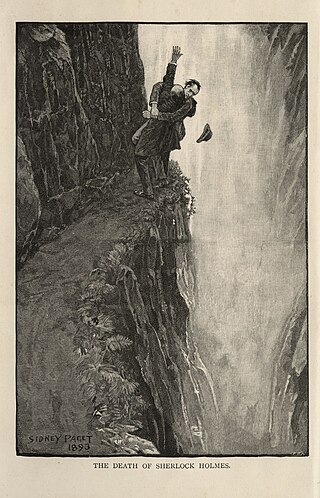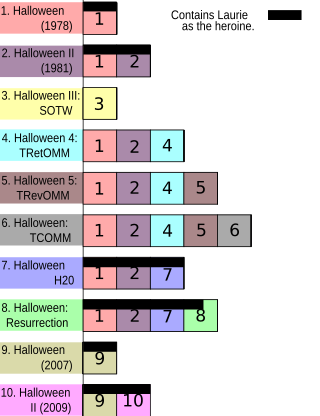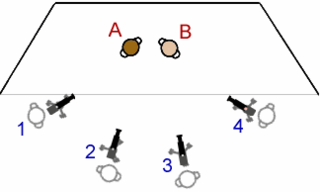A film crew is a group of people, hired by a production company, for the purpose of producing a film or motion picture. The crew is distinguished from the cast, as the cast are understood to be the actors who appear in front of the camera or provide voices for characters in the film. The crew is also separate from the producers, as the producers are the ones who own a portion of either the film studio or the film's intellectual property rights. A film crew is divided into different departments, each of which specializes in a specific aspect of the production. Film crew positions have evolved over the years, spurred by technological change, but many traditional jobs date from the early 20th century and are common across jurisdictions and filmmaking cultures.

Retroactive continuity, or retcon for short, is a literary device in which facts in the world of a fictional work which have been established through the narrative itself are adjusted, ignored, supplemented, or contradicted by a subsequently published work which recontextualizes or breaks continuity with the former.

A storyboard is a graphic organizer that consists of illustrations or images displayed in sequence for the purpose of pre-visualizing a motion picture, animation, motion graphic or interactive media sequence. The storyboarding process, in the form it is known today, was developed at Walt Disney Productions during the early 1930s, after several years of similar processes being in use at Walt Disney and other animation studios.
A screenplay, or script, is a written work by screenwriters for a film, television show, or video game. A screenplay written for television is also known as a teleplay. Screenplays can be original works or adaptations from existing pieces of writing. A screenplay is a form of narration in which the movements, actions, expressions and dialogue of the characters are described in a certain format. Visual or cinematographic cues may be given, as well as scene descriptions and scene changes.

The reset button technique is a plot device that interrupts continuity in works of fiction. Simply put, the reset button device returns all characters and situations to the statusquo they held before a major change was introduced. It is typically used in the middle of a program to negate some portion of what came before. Often used in science fiction television series, animated series, soap operas, and comic books, the device accommodates dramatic changes to characters and the fictional universe that might otherwise invalidate the premise of the show's continuity. For example, writers may use the reset button technique to allow the audience to better experience the death of the lead character, which traditionally would not be possible without effectively ending the work or significantly altering its course.

A film transition is a technique used in the post-production process of film editing and video editing by which scenes or shots are combined. Most commonly this is through a normal cut to the next shot. Most films will also include selective use of other transitions, usually to convey a tone or mood, suggest the passage of time, or separate parts of the story. These other transitions may include dissolves, L cuts, fades, match cuts, and wipes.

A crossover is the placement of two or more otherwise discrete fictional characters, settings, or universes into the context of a single story. They can arise from legal agreements between the relevant copyright holders, common corporate ownership or unofficial efforts by fans.
A take is a single continuous recorded performance. The term is used in film and music to denote and track the stages of production.
Filmmaking or film production is the process by which a motion picture is produced. Filmmaking involves a number of complex and discrete stages, beginning with an initial story, idea, or commission. Production then continues through screenwriting, casting, pre-production, shooting, sound recording, post-production, and screening the finished product before an audience, which may result in a film release and exhibition. The process is nonlinear, as the director typically shoots the script out of sequence, repeats shots as needed, and puts them together through editing later. Filmmaking occurs in a variety of economic, social, and political contexts around the world, and uses a variety of technologies and cinematic techniques to make theatrical films, episodic films for television and streaming platforms, music videos, and promotional and educations films.

Principal photography is the phase of producing a film or television show in which the bulk of shooting takes place, as distinct from the phases of pre-production and post-production.

In filmmaking, the 180-degree rule is a basic guideline regarding the on-screen spatial relationship between a character and another character or object within a scene. The rule states that the camera should be kept on one side of an imaginary axis between two characters, so that the first character is always frame right of the second character. Moving the camera over the axis is called jumping the line or crossing the line; breaking the 180-degree rule by shooting on all sides is known as shooting in the round.
This article contains a list of cinematic techniques that are divided into categories and briefly described.
A scene is a dramatic part of a story, at a specific time and place, between specific characters. The term is used in both filmmaking and theatre, with some distinctions between the two.
A script supervisor is a member of a film crew who oversees the continuity of the motion picture including wardrobe, props, set dressing, hair, makeup and the actions of the actors during a scene. The notes recorded by the script supervisor during the shooting of a scene are used to help the editor cut the scene. They are also responsible for keeping track of the film production unit's daily progress. The script supervisor credit is typically in the closing credits of a motion picture. Script supervisors are a department head and play a crucial role in the shooting of a film. It is the script supervisor's job to monitor the camera shots, seeking to maintain coherence between the scenes.
The Buffyverse canon consists of materials that are thought to be genuine and those events, characters, settings, etc., that are considered to have inarguable existence within the fictional universe established by the television series Buffy the Vampire Slayer. The Buffyverse is expanded through other additional materials such as comics, novels, pilots, promos and video games which do not necessarily take place in exactly the same fictional continuity as the Buffy episodes and Angel episodes. Star Trek, Star Wars, Stargate and other prolific sci-fi and fantasy franchises have similarly gathered complex fictional continuities through hundreds of stories told in different formats.

The multiple-camera setup, multiple-camera mode of production, multi-camera or simply multicam is a method of filmmaking and video production. Several cameras—either film or professional video cameras—are employed on the set and simultaneously record or broadcast a scene. It is often contrasted with a single-camera setup, which uses one camera.
A traditional production board, stripboard, or production strip is a filmmaking term for a cardboard or wooden chart displaying color-coded strips of paper, each containing information about a scene in the film's shooting script. The strips can then be rearranged and laid out sequentially to represent the order one wants to film in, providing a schedule that can be used to plan the production. This is done because most films are shot "out of sequence," meaning that they do not necessarily begin with the first scene and end with the last. For logistical purposes, scenes are often grouped by talent or location and are arranged to accommodate the schedules of cast and crew. A production board is not to be confused with a stripboard used for electronics prototyping.
In filmmaking, a pick-up is a small, relatively minor shot filmed or recorded after the fact to augment footage already shot. When entire scenes are redone, it is referred to as a re-shoot or additional photography.
Shot-for-shot is a way to describe a visual work that is transferred almost completely identically from the original work without much interpretation.
This glossary of motion picture terms is a list of definitions of terms and concepts related to motion pictures, filmmaking, cinematography, and the film industry in general.








